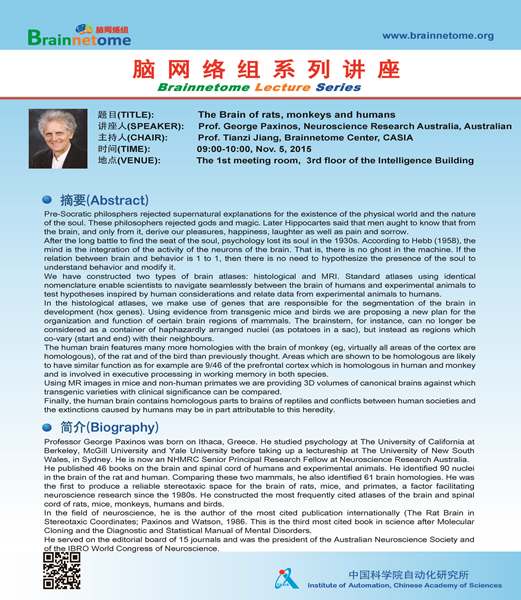Professor George Paxinos's Lecture - The Brains of rats, monkeys and humans
Title: The Brains of rats, monkeys and humans
Speaker: Prof. George Paxinos, Neuroscience Research Australia, Australian
Chair: Prof. Tianzi Jiang, Brainnetome Center, CASIA
Time: 9:00-10:00 Nov. 5, 2015
Venue: The 1st meeting room, 3rd floor of the Intelligence Building
[Abstract]
Pre-Socratic philosphers rejected supernatural explanations for the existence of the physical world and the nature of the soul. These philosophers rejected gods and magic. Later Hippocartes said that men aught to know that from the brain, and only from it, derive our pleasures, happiness, laughter as well as pain and sorrow.
After the long battle to find the seat of the soul, psychology lost its soul in the 1930s. According to Hebb (1958), the mind is the integration of the activity of the neurons of the brain. That is, there is no ghost in the machine. If the relation between brain and behavior is 1 to 1, then there is no need to hypothesize the presence of the soul to understand behavior and modify it.
We have constructed two types of brain atlases: histological and MRI. Standard atlases using identical nomenclature enable scientists to navigate seamlessly between the brain of humans and experimental animals to test hypotheses inspired by human considerations and relate data from experimental animals to humans.
In the histological atlases, we make use of genes that are responsible for the segmentation of the brain in development (hox genes). Using evidence from transgenic mice and birds we are proposing a new plan for the organization and function of certain brain regions of mammals. The brainstem, for instance, can no longer be considered as a container of haphazardly arranged nuclei (as potatoes in a sac), but instead as regions which co-vary (start and end) with their neighbours.
The human brain features many more homologies with the brain of monkey (eg, virtually all areas of the cortex are homologous), of the rat and of the bird than previously thought. Areas which are shown to be homologous are likely to have similar function as for example are 9/46 of the prefrontal cortex which is homologous in human and monkey and is involved in executive processing in working memory in both species.
Using MR images in mice and non-human primates we are providing 3D volumes of canonical brains against which transgenic varieties with clinical significance can be compared.
Finally, the human brain contains homologous parts to brains of reptiles and conflicts between human societies and the extinctions caused by humans may be in part attributable to this heredity.
[Biography]
Professor George Paxinos was born on Ithaca, Greece. He studied psychology at The University of California at Berkeley, McGill University and Yale University before taking up a lectureship at The University of New South Wales, in Sydney. He is now an NHMRC Senior Principal Research Fellow at Neuroscience Research Australia.
He published 46 books on the brain and spinal cord of humans and experimental animals. He identified 90 nuclei in the brain of the rat and human. Comparing these two mammals, he also identified 61 brain homologies. He was the first to produce a reliable stereotaxic space for the brain of rats, mice, and primates, a factor facilitating neuroscience research since the 1980s. He constructed the most frequently cited atlases of the brain and spinal cord of rats, mice, monkeys, humans and birds.
In the field of neuroscience, he is the author of the most cited publication internationally (The Rat Brain in Stereotaxic Coordinates; Paxinos and Watson, 1986. This is the third most cited book in science after Molecular Cloning and the Diagnostic and Statistical Manual of Mental Disorders.
He served on the editorial board of 15 journals and was the president of the Australian Neuroscience Society and of the IBRO World Congress of Neuroscience.

